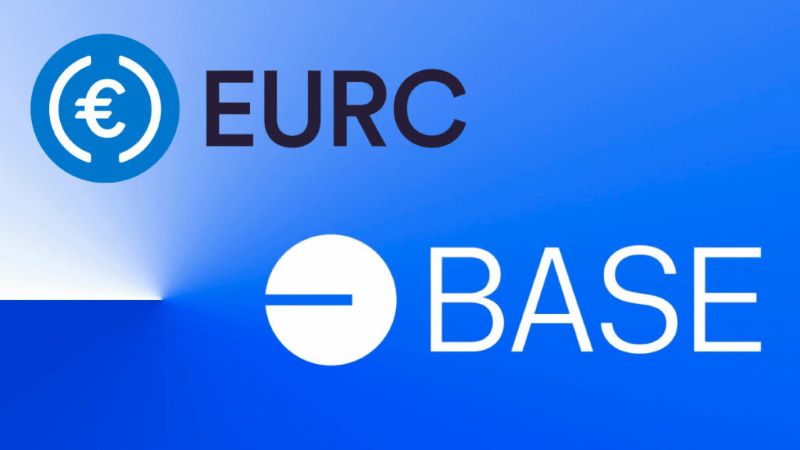The EURC stablecoin has achieved a historic milestone, surpassing 90 million USD in supply. Issued by Circle, EURC is emerging as a key player in the cryptocurrency market, particularly within compliant stablecoins. Its growth, driven by integration into Layer-2 solutions like Coinbase’s Base, highlights the Euro’s increasing relevance in the blockchain ecosystem.
What is EURC Stablecoin?
EURC is a euro-pegged stablecoin issued by Circle, the same company behind the popular USDC stablecoin. Launched in June 2022, EURC aims to provide a stable digital asset that can facilitate transactions and serve as a reliable store of value within the cryptocurrency ecosystem. Unlike cryptocurrencies known for their volatility, stablecoins are designed to maintain a stable value by pegging them to traditional fiat currencies, in this case, the euro.
A Record-Breaking Supply
As of October 25, 2024, the circulating supply of EURC has surged to 91.8 million, with a market capitalization nearing $99.4 million. This marks a significant milestone, as it is the first time that EURC has exceeded the threshold of 90 million euros in circulation. The impressive growth trajectory has positioned EURC as the largest euro-backed stablecoin by market cap, illustrating the increasing adoption of digital currencies linked to fiat currencies.
The surge in EURC’s supply can be attributed to several key factors:
- Integration with Layer-2 Solutions: The most significant catalyst for EURC’s recent growth is its integration with Layer-2 solutions, particularly the Base network developed by Coinbase. This layer-2 protocol offers lower transaction fees and faster processing times, making it more attractive for users and developers.
- Regulatory Clarity: EURC has benefited from the regulatory environment in the European Union, particularly the Markets in Crypto-Assets (MiCA) framework, which aims to create a clear regulatory landscape for cryptocurrencies. Circle became the first stablecoin issuer to comply with these regulations in July 2024, resulting in enhanced trust and legitimacy for EURC.
- Growing Demand for Euro-Backed Stablecoins: The demand for euro-backed stablecoins is rising, as they provide an alternative for users who prefer the stability of the euro over other fiat currencies. As more businesses and individuals engage in crypto transactions, having a stablecoin pegged to the euro enhances usability and accessibility.
Market Position and Comparison
While EURC has made significant strides, it still occupies a small fraction of the overall stablecoin market. The total market capitalization of all stablecoins currently stands at approximately $176.6 billion, with USD-pegged stablecoins like Tether’s USDT and Circle’s USDC dominating the space.
- USDT holds a staggering 75% market share, translating to a supply of $126.1 billion.
- USDC, on the other hand, comprises about 21% of the market with a supply of $36.9 billion.
In contrast, EURC’s contribution is less than 0.1%, highlighting the challenges ahead for euro-based stablecoins.
EURC vs. EURT
It is also important to note the competition within the euro-stablecoin space. Tether’s EURT, which is also euro-backed, has a supply of 25.6 million and a market cap of $27.5 million. However, EURT currently lacks the legal status and regulatory clarity that EURC enjoys under the MiCA framework. This distinction could play a crucial role in attracting users to EURC in the long run.
The Role of Stablecoins in the Crypto Ecosystem
Stablecoins, including EURC, play a vital role in the cryptocurrency ecosystem. They serve multiple purposes, including:
- Facilitating Transactions: Stablecoins provide a reliable medium of exchange for users who wish to trade or transact without the volatility associated with traditional cryptocurrencies like Bitcoin or Ethereum.
- Enhancing Liquidity: Stablecoins contribute to market liquidity by allowing users to easily enter and exit positions, thereby reducing slippage and improving trading efficiency.
- Enabling DeFi Participation: Stablecoins are crucial in decentralized finance (DeFi) applications, where they are often used for lending, borrowing, and yield farming. The ability to utilize stablecoins in DeFi protocols can help mitigate risk while still providing opportunities for yield generation.
Future Prospects
The recent achievements of EURC signal a growing recognition of euro-denominated stablecoins, but there is still much work to be done. Patrick Hansen, Circle’s Director of Strategy and Policy for the EU, has acknowledged that while the euro is beginning to attract attention in the blockchain space, there is a pressing need for increased liquidity, additional listings, and enhanced utility.
As the cryptocurrency market continues to evolve, the rise of EURC reflects not only the growing demand for stablecoins but also the increasing significance of regulatory frameworks in shaping the future of digital assets. With its recent milestones, EURC stands at the forefront of euro-backed stablecoins, poised to carve out its niche in an otherwise USD-dominated landscape.
Investors and crypto enthusiasts alike should keep a close eye on EURC and its competitors as the stablecoin market evolves, presenting new opportunities and challenges. As adoption increases and the regulatory landscape solidifies, euro-based stablecoins like EURC may very well become a critical component of the broader cryptocurrency ecosystem.
Stay updated on the latest trends in stablecoins and crypto! Follow us for more insights and expert analysis on EURC and the evolving cryptocurrency landscape.

